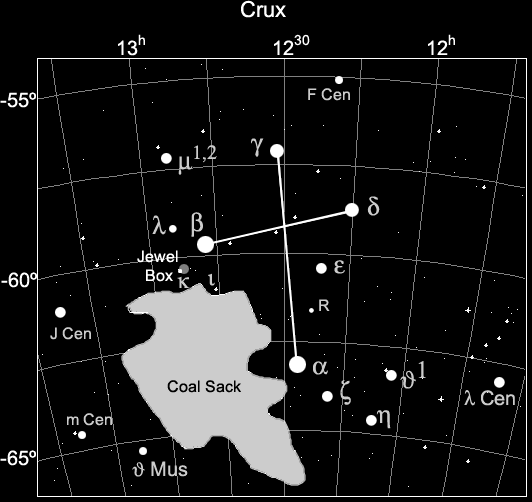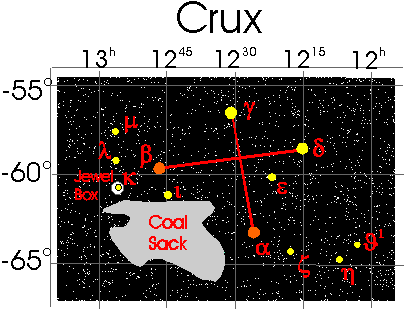
Crux is the signpost of the southern hemisphere: the Southern Cross. In antiquity its stars belonged to Centaurus, but the familiar sight became a constellation of its own in the Sixteenth Century when seamen started to become more familiar with the stars of the southern hemisphere. Beginning at alpha Crucis one can easily find the Coal Sack, a particularly large dark nebula quite striking in contrast to the richness of the Milky Way. The Jewel Box is another delight, not just the finest cluster in the Southern Hemisphere but one of the best in all the heavens.

Alpha Crucis is actually two stars, a splendid telescopic binary system with a 1.3 magnitude primary and its equally bright 1.6 companion, 4.4" away at PA 115º. Acrux, as the star is also called, forms the southern tip of the cross, as seen in the Southern Hemisphere, looking south, in March-May. The entire Southern Cross should be visible in the same FOV.
Beta Crucis, at a visual magnitude of 1.3, is nearly as bright as alpha. It forms the eastern tip of the cross. With beta Crucis at the top of your glasses you can see much of the Coal Sack. Dark nebulae such as The Coal Sack are vast regions of interstellar gases and dust thick enough to block out any starlight from penetrating. The Coal Sack is even more dramatic as it is found in the centre of the Milky Way. In the same region, southeast of beta, is the remarkable Jewel Box star cluster (NGC 4755), one of the finest in all the heavens. While you can get a glimpse of its brilliance in binoculars, small telescopes reveal fifty or so multi-coloured stars (mostly reds and blues). The brightest member is kappa Crucis, and its distance of 7500 light years gives us a good idea of the distance of the cluster in general.
